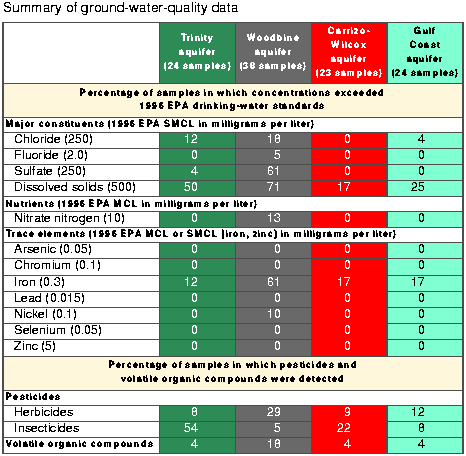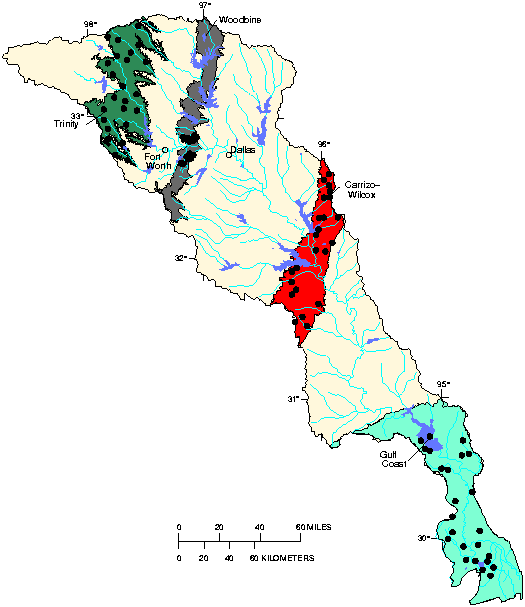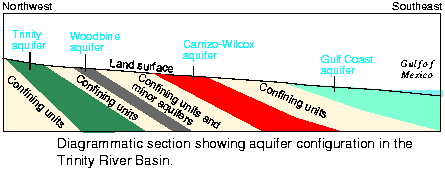The Trinity, Woodbine, Carrizo-Wilcox, and Gulf Coast aquifers (and intervening confining units and minor aquifers) in the Trinity River Basin occur as a series of sloping layers that begin at land surface and become more deeply buried toward the gulf coast. The aquifer outcrops delineated on a map of the basin appear as generally coast-parallel bands. The Trinity, Carrizo-Wilcox, and Gulf Coast are major aquifers, on the basis of the quantity of water that can be supplied to wells. The Woodbine is a minor aquifer, but it is important to the study of water-quality conditions in the basin because it underlies the urban Dallas-Fort Worth metropolitan area.
Groundwater samples were collected from wells in the outcrops of the four aquifers from August 1993 to August 1994 and analyzed for nutrients, major inorganic compounds, trace elements, pesticides, organic carbon, and VOCs.
Trinity Aquifer
On the basis of samples from 24 wells less than 200 feet deep in the Trinity aquifer outcrop, groundwater in the uppermost zone of the aquifer did not exceed 1996 EPA primary drinking-water standards (MCLs) for the analyzed constituents but has higher than acceptable dissolved solids concentration (salinity) in water from one-half of the wells. (Salinity has an EPA secondary MCL [SMCL]. An SMCL is based on factors such as taste and odor that affect the potability of water but do not pose a health concern.) The salinity could occur naturally or it could be from brines associated with oil and gas production.
Pesticides were detected in Trinity aquifer wells. The insecticide diazinon was detected in nearly one-half the samples, and the DDT derivative p,p'-DDE was detected in samples from four wells. None of the concentrations exceeded the 1996 EPA lifetime HA for diazinon. The herbicide atrazine or its metabolite deethylatrazine was detected in two wells. Benzene, a component of gasoline, was detected in one well at a concentration
show the vulnerability of these aquifers to contamination.
less than the 1996 MCL. The pesticide and VOC detections show the vulnerability of shallow groundwater in the Trinity aquifer to contamination. The pathway of such compounds into shallow groundwater could be through natural recharge or recharge along the outside of well casings that are not completely sealed at the land surface.
Woodbine Aquifer
>P> Analyses of samples from the outcrop of the Woodbine aquifer could indicate shallow groundwater contamination associated with urban land use. Twenty-eight specially constructed monitoring wells less than 50 feet deep were used to sample water in the uppermost aquifer zone. Ten domestic wells were used to sample water in the deeper aquifer zone (50 to 150 feet deep). The water in the Woodbine aquifer (Reutter, 1996) can be naturally saline and high in iron and sulfate---71 percent of the 38 Woodbine water samples exceeded the EPA SMCL for dissolved solids, and 61 percent of the samples exceeded the SMCLs for both iron and sulfate. Five of the 38 samples exceeded the EPA MCL for nitrate.Herbicides were detected in 11 of the 38 wells; p,p'-DDE was detected in samples from two wells. None of the sample concentrations of pesticides for which EPA has established MCLs or HAs exceeded those standards.
Samples from seven wells have detectable concentrations of VOCs. The most commonly detected VOC was MTBE (methyl tert-butyl ether), a gasoline additive, in the urban part of the Woodbine aquifer. The sample from one shallow monitoring well has concentrations of several VOCs greater than 10 micrograms per liter. Tetrachloroethylene and trichloroethylene, solvents for which the 1996 MCL is 5 micrograms per liter, were detected at concentrations of 6,000 and 230 micrograms per liter, respectively. Chloroethylene (vinyl chloride), a compound used as a solvent and as a refrigerant, for which the 1996 MCL is 2 micrograms per liter, was detected at a concentration of 32 micrograms per liter; and cis-1,2-dichloroethylene, a solvent for which the 1996 MCL is 70 micrograms per liter, was detected at a concentration of 82 micrograms per liter.
Carrizo-Wilcox Aquifer
In the outcrop of the Carrizo-Wilcox aquifer, 23 wells less than 300 feet deep were sampled. Samples from seven wells had dissolved solids or iron concentrations that exceeded EPA SMCLs. As in the Trinity aquifer, higher than acceptable salinity could occur naturally or be related to historical brine disposal from oil and gas production; the higher than acceptable iron concentrations occur naturally. Herbicides were detected in samples from two wells and insecticides in samples from five wells. Trichlorofluoromethane, a VOC used as solvent, was detected in the sample from one well. None of the pesticides or VOCs for which EPA has established MCLs or HAs had concentrations that exceeded those standards.
Gulf Coast Aquifer
In the outcrop of the Gulf Coast aquifer, 24 wells less than 250 feet deep were sampled. Samples from six wells had dissolved solids concentrations that exceeded the EPA SMCL. The excess salinity probably is related to historical brine disposal from oil and gas production. Herbicides were detected in samples from three wells and insecticides in samples from two wells. Trichloromethane, a VOC used as a refrigerant or a solvent, was detected in the sample from one well. As in the Carrizo-Wilcox aquifer, none of the pesticides or VOCs for which the EPA has established MCLs or HAs had concentrations that exceeded those standards.
drinking-water MCLs or SMCLs for trace elements, except for iron at some locations.
A comparison of pesticides detected in shallow groundwater in the outcrops with those detected in streams in the outcrops (excluding the main-stem Trinity River sites) indicates that stream water generally contains a greater number of pesticides at higher concentrations than shallow groundwater. A larger pesticide presence in streams than in groundwater implies that pesticides applied to the land are more readily transported into the streams by runoff than into the shallow groundwater by natural recharge or recharge associated with well construction (Brown, 1995).



